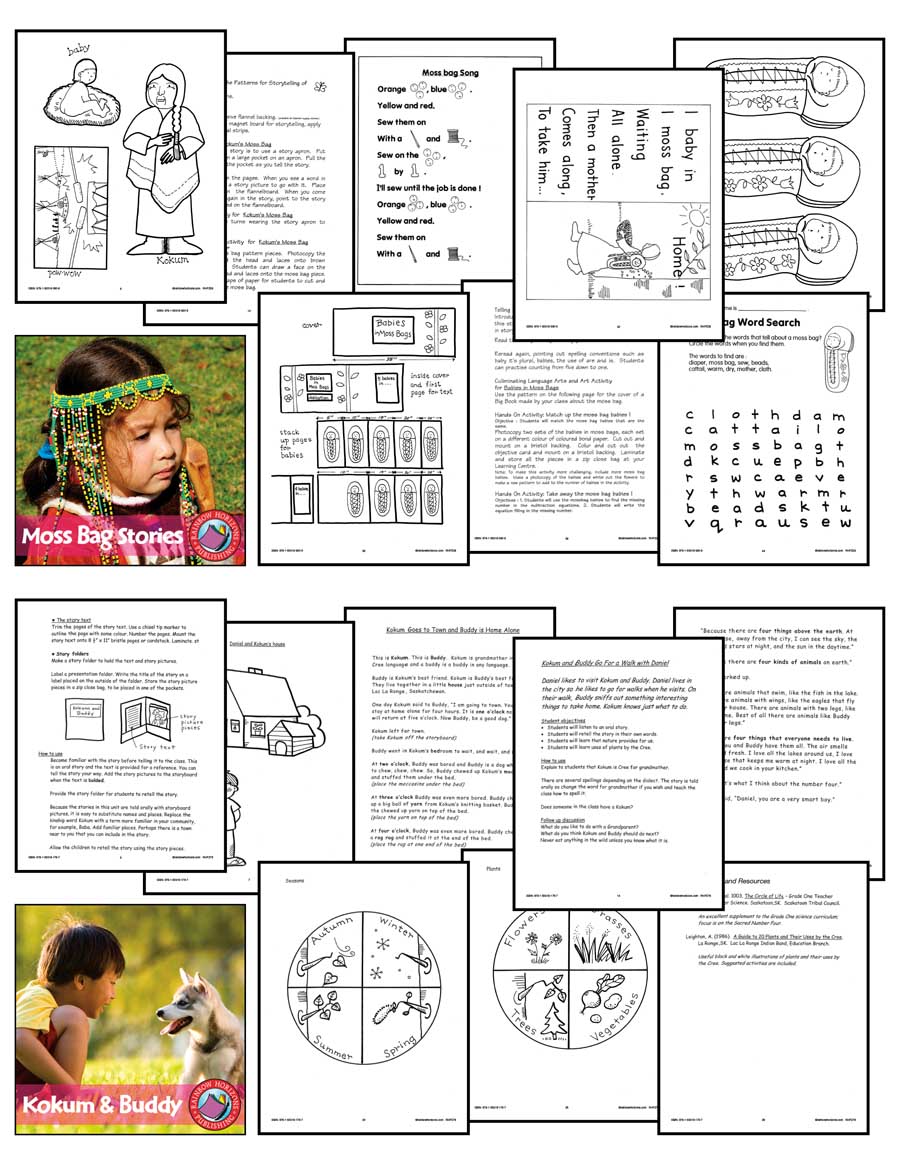Canadian Studies >
Grades K, 1, 2 >
Canada's First Nations People SET
Canada's First Nations People SET
Grades K to 2 - Print Book - Lesson Plan

Order #: SET102
ISBN13: 978-1-77167-560-4
Grades: K, 1, 2
Reading Level: K-2
Total Page: 156
Author: Vera Trembach
Tweet
Description
Our Canada's First Nations People SET combines 3 titles in one bundle:
Z27 - Big Book For First Nations
Z28 - Moss Bag Stories
Z76 - Kokum & Buddy
About Big Book For First Nations:
B is for Bannock — M is for Moccasin — T is for Tipi. The stories featured in our resource are being enjoyed by children and teachers across Canada in both provincial and First Nations schools. Aboriginal children read about things that are familiar and non-Aboriginal children learn about the cultures of First Nations people. Students will learn about traditional foods, develop their listening skills, participate in letter sequencing activities and write an acrostic food poem. Included are patterns and text to make 3 big books: B is for Bannock — a recipe for bannock, patterns for big book and little book stories; Inside My Tipi — patterns for big and little book stories, creative writing pages; and M is for Moccasins.
About Moss Bag Stories:
Our unit consists of stories about Saskatchewan's aboriginal cultures. Moss Bag Stories can be integrated into your curriculum under family studies. The stories tell about one way that Indian mothers take care of their young children. Moss Bags are the environmentally friendly diapers that native mothers used for their babies. Made of moss and cattails, native mothers would pick the moss and cattails in the Fall. They wanted to have a supply of diapers that would last them the winter months. The moss was cleaned and dried, and mixed with the fuzzy part of the cattail.
About Kokum & Buddy:
Our unit contains three storyboard stories about a young boy, a grandmother, and Buddy — her dog. Non-native children learn a bit about the culture of First Nations people in northern Saskatchewan. Teachers of aboriginal children can adapt the story to suit their own First Nations community. Use the kinship term for grandmother from any language. Replace the name of the dog with a dog the children are familiar with and so on. Why not draw and add your own story pieces and give Kokum and Buddy a whole new adventure?
This Canada and Primary Studies Set provides a teacher and student section with reading passages, activities, recipes, word search, math equations, storyboard stories, discussion questions, and hands-on activities to create a well-rounded lesson plan.
Z27 - Big Book For First Nations
Z28 - Moss Bag Stories
Z76 - Kokum & Buddy
About Big Book For First Nations:
B is for Bannock — M is for Moccasin — T is for Tipi. The stories featured in our resource are being enjoyed by children and teachers across Canada in both provincial and First Nations schools. Aboriginal children read about things that are familiar and non-Aboriginal children learn about the cultures of First Nations people. Students will learn about traditional foods, develop their listening skills, participate in letter sequencing activities and write an acrostic food poem. Included are patterns and text to make 3 big books: B is for Bannock — a recipe for bannock, patterns for big book and little book stories; Inside My Tipi — patterns for big and little book stories, creative writing pages; and M is for Moccasins.
About Moss Bag Stories:
Our unit consists of stories about Saskatchewan's aboriginal cultures. Moss Bag Stories can be integrated into your curriculum under family studies. The stories tell about one way that Indian mothers take care of their young children. Moss Bags are the environmentally friendly diapers that native mothers used for their babies. Made of moss and cattails, native mothers would pick the moss and cattails in the Fall. They wanted to have a supply of diapers that would last them the winter months. The moss was cleaned and dried, and mixed with the fuzzy part of the cattail.
About Kokum & Buddy:
Our unit contains three storyboard stories about a young boy, a grandmother, and Buddy — her dog. Non-native children learn a bit about the culture of First Nations people in northern Saskatchewan. Teachers of aboriginal children can adapt the story to suit their own First Nations community. Use the kinship term for grandmother from any language. Replace the name of the dog with a dog the children are familiar with and so on. Why not draw and add your own story pieces and give Kokum and Buddy a whole new adventure?
This Canada and Primary Studies Set provides a teacher and student section with reading passages, activities, recipes, word search, math equations, storyboard stories, discussion questions, and hands-on activities to create a well-rounded lesson plan.







